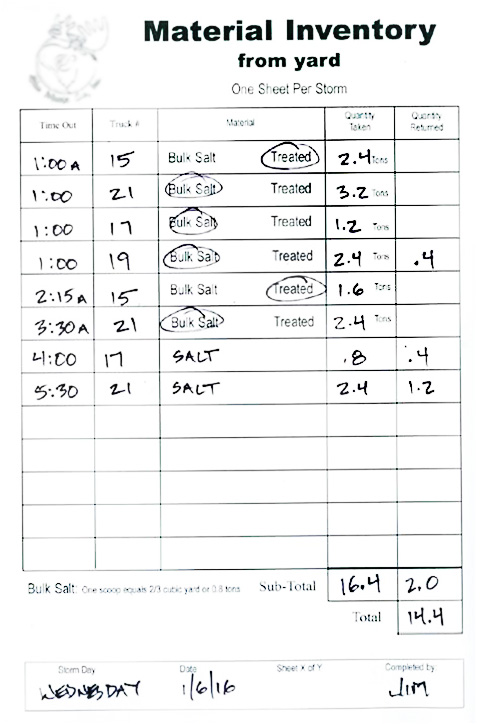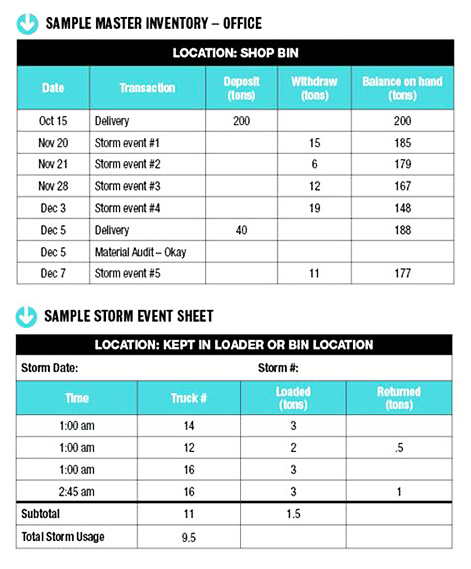Commonly asked questions about ice melters
The TRUTH about LEED Certified Ice Melt
Icemelters: What you should know

According to this article written by Douglas Freer, CSP, a management consultant Peter Drucker once said, “If you can’t measure something, you can’t manage it.” This axiom may not apply to all things in business, but it is relevant to managing your assets, and in particular, ice control chemicals. In today’s increasingly competitive marketplace, finding efficiencies and room for improvement can provide an advantage in your business space.
Next to labor, your ice control chemicals may represent the largest variable expense, often consuming 8% to 15% or more of your season’s budget. How do you manage your inventory to ensure you get the best return? Are you using too much product, or could you use less and get the same results? How much shrinkage (theft) or spoilage (waste) do you have? Do you even know? If you don’t have a system for managing your inventory and product, you can’t determine “normal” usage and benchmark to determine if you’re ahead or behind expectations.
What is salt accounting?
Salt accounting is the process of measuring and tracking ice control chemicals purchased and then used during a season. The salt accounting system produces data that informs your decision making as it relates to operations, sales and expenses.
More simply, salt accounting is a check register for your ice control chemicals. You make deposits (credits) when you take a delivery of material and withdrawals (debits) when you use material to service your sites.
At a minimum, your salt accounting system should tell you how much material you have purchased and when you used it. This system can be improved if you record where the salt is used by having salt truck drivers collect data for each site they service.
One size doesn’t fit all
Your salt accounting system does not need to be complicated; in fact, keeping it as simple as possible for your specific needs is important for making salt accounting sustainable. Fancy applications on devices are not necessary to manage an effective system. The scope or sophistication of your salt accounting system will depend on your needs, which in large part is driven by the size of your business. It’s important to collect the same basic data whether you use 10 or 10,000 tons a season. The more ice control chemical you use the more incentive to find savings, since a 10% savings of a larger whole number will mean more dollars for the bottom line.
Now is a good time to review your current procedures and decide what changes you will make so you are ready when the first load of salt arrives.
The benefits of measuring
Measuring and managing your ice control chemicals has multiple benefits. If you effectively track the flow of material through your business by event, driver and property serviced, you will have important data that can provide insights into developing and improving best practices. Feedback from your system will help to increase or improve:
Production efficiency.
Feedback to drivers about proper application rates and methods reduces waste and guesswork and improves their effectiveness, resulting in more efficient service.
Storm management.
Reduced consumption increases salt truck load range, which improves routing, reduces drive time for reloading and increases service consistency. Improved material management and awareness will reduce mistakes and the possibility of running out of material at critical times.
Cost control.
Reduce costs by using what is necessary, avoiding waste and reducing overall material consumption, which reduces inventory and related carrying costs.
Inventory management.
Determine how much product is necessary to service your client base for the season so you can accurately order in the preseason and manage in-season inventory levels.
Client expectations.
With increased attention to detail, you are more likely to meet or exceed client expectations due to consistent and improved performance by avoiding under- or over-application.
Legal defense.
Tracking material use at the client level provides useful information to dispute slip-fall claims.
Confidence.
Crew members will have increased confidence in their work because they understand what they are doing and the accounting process will become second nature.
Best practices.
You’ll be able to compare variables and measure outcomes as you experiment and test products and equipment, leading to operational tweaks in search of the sweet spot, resulting in the definition of your company’s best practices. If you don’t measure, you won’t be certain that one change or variable is better than another.
Developing a process
A very basic salt accounting system measures the amount of ice control chemical used per event, which allows for storm-event job costing. You could track this by truck driver and determine approximately how much product, on average, the driver uses and estimate application rates for a given route during an event.
However, with a little more tracking you can record salt usage at each site. Tracking the information to each specific site is not complicated and can be accomplished with a paper-based system, which can be converted to an electronic system if the use of technology is justified and cost effective.
Setting up an effective salt accounting system means answering these questions:
• Who handles the data? The material loaded into each truck is recorded by the loader operator as well as the driver, who records site-specific information. Office administrators input the data into the database or storage system for future retrieval.
• What materials were used? Was it bulk or bagged, straight granular salt or treated material? Did it include pre-wetting with a liquid system?
• Where were the materials sourced (shop bin, satellite bin, retail location, etc.)?
• Where and how much material was used?
• Why was the application made? What site and weather conditions required the application?
• What was the method of application? What truck and/or system was used to apply and what were the settings?
Master inventory sheet
A master inventory register is kept for each bin or storage location and for each product. This relatively simple register, or transaction journal, records the deposits and withdrawals from the inventory, giving you a quick reference on how much total material has been purchased, used and remains in inventory.
Keep a separate inventory register for each product that you use and for each location where product is stored. Physically checking inventory periodically will help uncover discrepancies, which can be investigated and rectified in a timely manner.

Storm event inventory sheet
A simple form filled out by the loader operator or by each driver provides a master log of the material applied for a particular storm event. The form records the material loaded and then returned (if any) at the end of the event, providing a total number of material units used by location.

Truck log
The driver log records the estimated amount of materials used during the event by recording how much was loaded into the truck and then how much was applied at each site. The driver is responsible for knowing how much material was applied and to ensure his calculations balance. If three tons of material were loaded and the truck came back empty, where and when were 6,000 pounds applied?
Automated measurement systems
Automated measurement systems are available to let the driver know how much material has been applied. Based on spinner rotation, hydraulic flow or some other means of measurement, the equipment is calibrated from known test measurements to provide close estimates on the units applied.
In the absence of an automated measurement system, the driver will have to visually estimate their load after each application in order to record the amount of material used.
With guidance, practice and time spent balancing the truck log, the driver will gain experience and become more proficient at estimating product use. Technology can be useful in collecting and processing data. Be leery of using technology if you don’t have a salt accounting system yet or if it isn’t sufficient to meet the needs of the business. Technology by itself is not a solution. First you need to know what kind of reports or information you want to get out of your system.
Calibration and application rates
Who decides how much material should be used in a given storm event or in a certain scenario? Does the driver make the call or do area managers or supervisors offer guidance? In the same storm scenario, one driver may feel that 500 pounds on a site is appropriate while another driver subscribes to the theory that more is better and decides to apply 1,000 pounds. Establishing application guidelines for each site gives your drivers a basic guideline for how much material should be used under “normal” conditions. For example, if the average application is 500 pounds per acre, a 3-acre property will generally need 1,500 pounds of product. This does not mean that your driver should always apply this amount, since conditions may warrant more or less. But a guideline will help them make that decision. You can take the application guidelines a step further by providing a site list with property size, and then adding incremental calculations for each site, ranging from a light to heavy application. For example, you may indicate in a light icing scenario that your target is 250 to 300 pounds per acre. The driver can consult the reference chart for each site they’re servicing and determine the target quantity required and apply with that estimate in mind, recording actual units applied.
Ultimately when it comes to calibration, not only are you ensuring your equipment is calibrated and working correctly, but you are dialing in your drivers so they can make an effective application. Applying ice control chemical from a moving truck at varying speeds in traffic and around obstacles is imprecise, but measuring and checking against expectations will help make the driver more efficient and effective.
Return loop
Once your system is in place, the first step is to reliably and accurately record and collect the data each storm event. After the storm event you need to review the paperwork or data collected for accuracy, and enter it into your record keeping system if this is not an automated process. This system can be paper based or managed in Excel or another database, making it easier to tabulate and manipulate data to share with others. With this type of data, you can begin to make more informed decisions and provide feedback to those who need the information, leading you to a more efficient and effective operation.
Doug Freer, CSP.